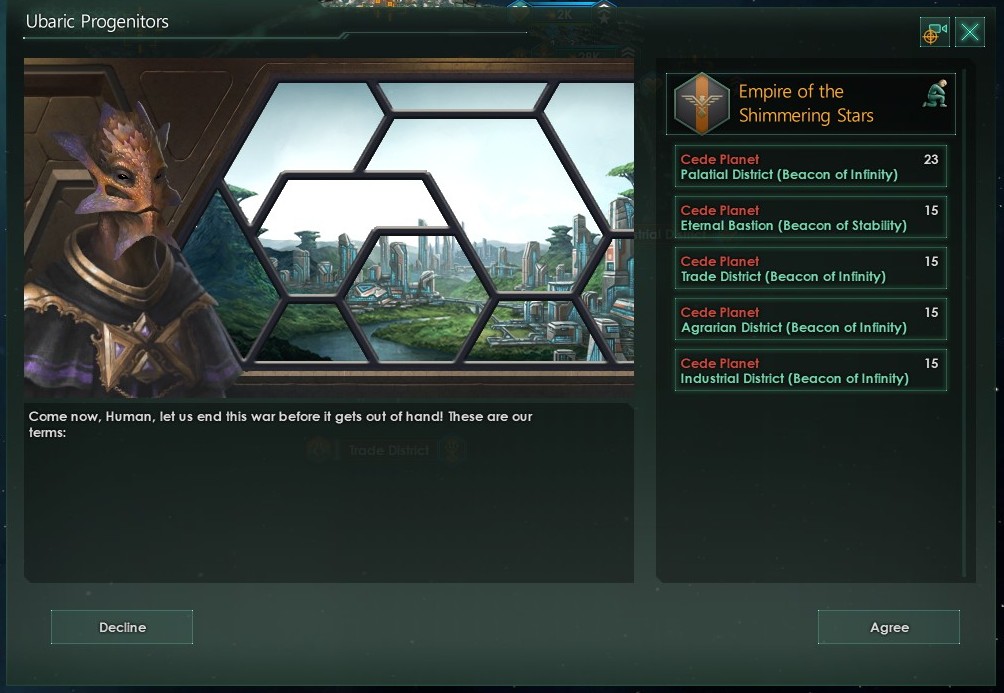
Amidst the brightly shining stars, the Mushroom Domain’s legacy shall endure. The Mushrooms were not the galaxy’s most populous species. They did not control its largest empire. Yet they were its most influential. It was a Mushroom-created federation that brought peace to the galaxy and defended it against an invading scourge, and it was a Mushroom battle fleet that fired the final, victorious shot.
One year after launch, Stellaris remains best approached as a science-fiction story generator. Its strengths and weaknesses are recognisable from launch: in Jesse Schell’s “toy vs game” classification scheme (a toy is something you play with, a game is a problem-solving activity approached with a playful attitude), Stellaris is still more of a toy than a game — not uncommon in the 4X and strategy genres, where a rich experience such as Total War or Master of Magic can represent more than the sum of its parts. Stellaris is not a balanced set of finely-honed decisions, and I wonder if it ever could be one without jeopardising what it does do well: providing a sandpit to enact grand sagas of galactic ambition.
More detailed thoughts below:
At a design level, this is still one of the most interesting 4X titles around. Thematically, Stellaris‘s well-written flavour events, randomly generated species (peer empires, brooding precursors, upliftable pre-spaceflight worlds, and more), and abundant science-fiction homages combine to produce a galaxy that is “ancient and full of wonders”. Later on, the galaxy begins dividing into blocs, precursor races awaken, and intergalactic invaders emerge, representing radical potential changes to the game board: when the victory screen popped up, my Mushrooms and their federation partners were defending against a mighty “Awakened Empire”, a once-dormant precursor now turned aggressively expansionist.
Mechanically, Stellaris is still strongest early on. Since the Utopia expansion came out, I’ve started four campaigns, shelved three after reaching the mid-game, and finished one. Early-game exploration remains the highlight; the mid-game is weakened by bland mechanics such as planetary construction and ship design. Patches and DLC have helped to some extent, providing new mid/late-game foes (Leviathans DLC), internal politics that feel rewarding instead of punitive (the 1.5 patch), buildable megastructures (the Utopia DLC — I’ve only built a few so far), and a Civ 5-style traditions system (Utopia again).
Applying mods and experimenting with custom game settings let me address the game’s weaknesses, build on its strengths, and tailor the experience to my preferences. In 4X games, I hate micromanaging large empires — I prefer a smaller scale where every settlement matters — and I prefer to play as a peaceful builder. I was able to achieve this in my completed Mushroom Domain game, a relaxing experience in which I let federation allies extend our control across the galaxy while I focused on building and exploration. To do so, I opted for a small galaxy with the proportion of habitable worlds set to 25% of the default. Meanwhile, I installed the More Events Mod (more to discover), Megastructures, Improved Megastructures, and Stellar Expansion (more to build), and assorted quality of life mods (AutoBuild). For future games, I intend to install Guilli’s Planet Modifiers (more planet variety) and perhaps The Zenith of Fallen Empires (ambitious endgame options).







